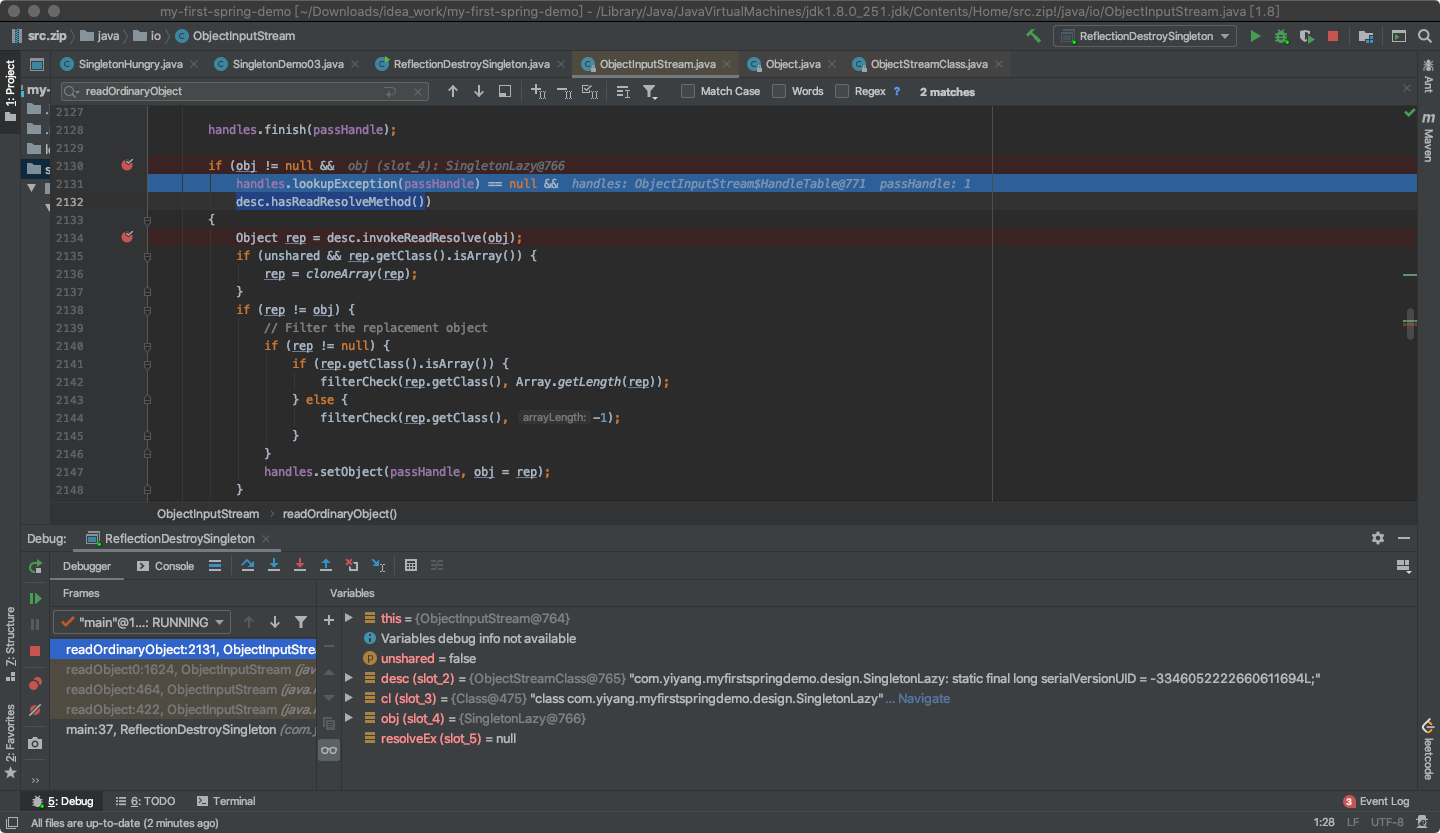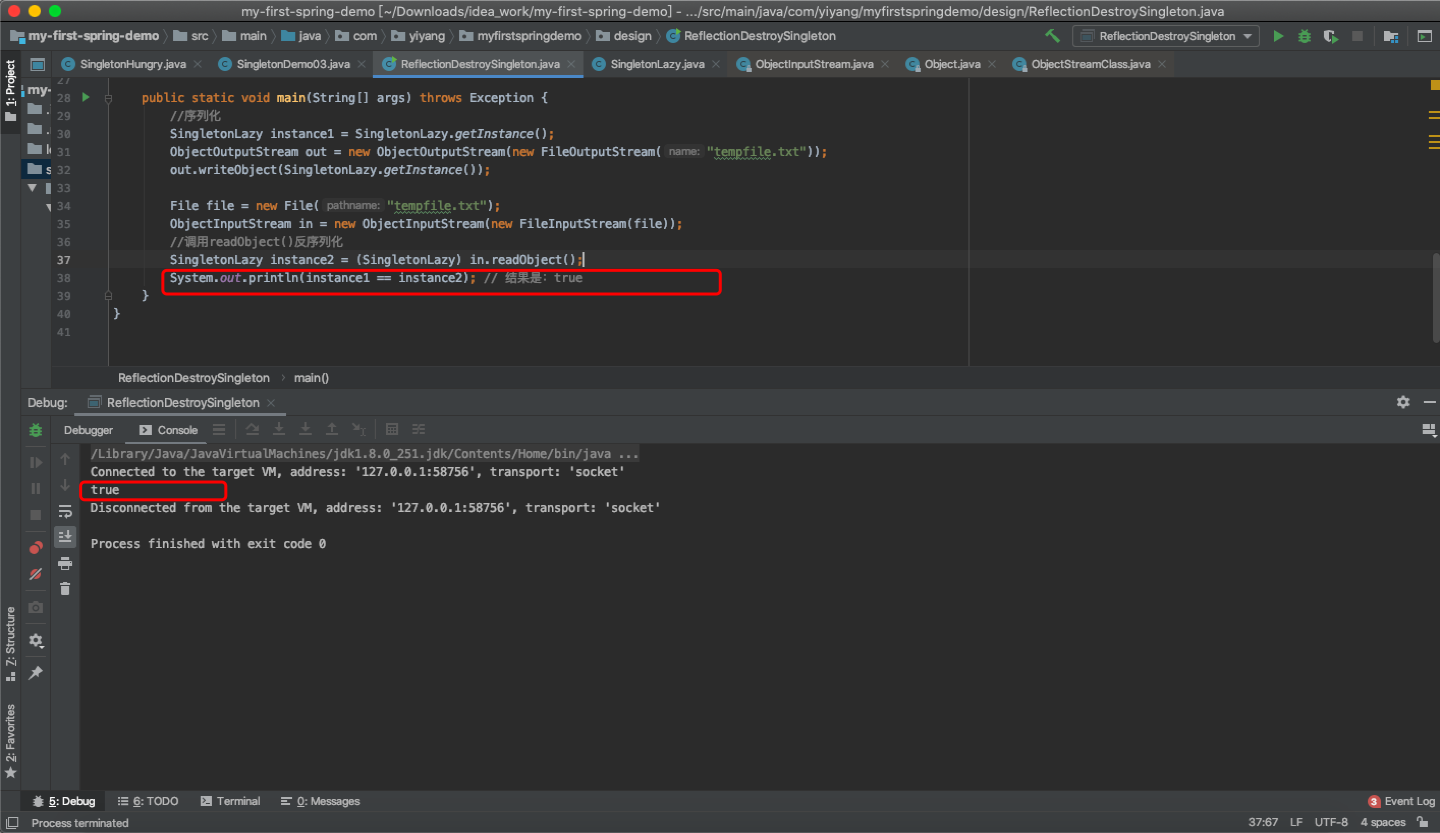java设计模式—单例模式(包含单例的破坏)
什么是单例模式?
保证一个了类仅有一个实例,并提供一个访问它的全局访问点。
单例模式的应用场景?
- 网站的计数器,一般也是采用单例模式实现,否则难以同步;
- Web应用的配置对象的读取,一般也应用单例模式,这个是由于配置文件是共享的资源;
- 数据库连接池的设计一般也是采用单例模式,因为数据库连接是一种数据库资源;
- 多线程的线程池的设计一般也是采用单例模式,这是由于线程池要方便对池中的线程进行控制。
单例的优缺点?
优点:
- 提供了对唯一实例的受控访问;
- 由于在系统内存中只存在一个对象,因此可以 节约系统资源,当 需要频繁创建和销毁的对象时单例模式无疑可以提高系统的性能;
- 避免对共享资源的多重占用
缺点:
- 不适用于变化的对象,如果同一类型的对象总是要在不同的用例场景发生变化,单例就会引起数据的错误,不能保存彼此的状态;
- 由于单利模式中没有抽象层,因此单例类的扩展有很大的困难;
- 单例类的职责过重,在一定程度上违背了“单一职责原则”。
单例的创建方式
饿汉式
类初始化时,会立即加载该对象,线程安全,效率高。
/**
* @Author 刘翊扬
* @Version 1.0
*/
public class SingletonHungry {
private static SingletonHungry instance = new SingletonHungry();
private SingletonHungry() {}
public static SingletonHungry getInstance() {
return instance;
}
}
验证:
public class Main {
public static void main(String[] args) {
SingletonHungry instance1 = SingletonHungry.getInstance();
SingletonHungry instance2 = SingletonHungry.getInstance();
System.out.println(instance1 == instance2); // 结果是true
}
}
优点:仅实例化一次,线程是安全的。获取实例的速度快
缺点:类加载的时候立即实例化对象,可能实例化的对象不会被使用,造成内存的浪费。
使用静态代码块
/**
* @author 刘翊扬
*/
public class HungrySingleton2 {
private static HungrySingleton2 instance = null;
private HungrySingleton2() {}
static {
instance = new HungrySingleton2();
}
private HungrySingleton2() {}
public static HungrySingleton2 getInstance() {
return instance;
}
}
懒汉式
public class SingletonLazy {
private static SingletonLazy instance;
private SingletonLazy() {}
public static SingletonLazy getInstance() {
if (instance == null) {
instance = new SingletonLazy();
}
return instance;
}
}
优点:在使用的时候,创建对象,节省系统资源
缺点:
- 如果获取实例时,初始化的工作量较多,加载速度会变慢,影响系统系能
- 每次获取对象,都要进行非空检查,系统开销大
- 非线程安全,当有多个线程同时调用 getInstance()方法,时,会有线程安全问题,可能导致创建多个对象
静态内部类
/**
* @Author 刘翊扬
* @Version 1.0
*/
public class SingletonDemo03 {
private SingletonDemo03() {}
public static class SingletonClassInstance {
private static final SingletonDemo03 instance = new SingletonDemo03();
}
public static SingletonDemo03 getInstance() {
return SingletonClassInstance.instance;
}
}
优势:兼顾了懒汉模式的内存优化(使用时才初始化)以及饿汉模式的安全性(不会被反射入侵)。
劣势:需要两个类去做到这一点,虽然不会创建静态内部类的对象,但是其 Class 对象还是会被创建,而且是属于永久带的对象。
使用枚举
枚举本身就是单例的,一般在项目中定义常量。
例如:
/**
* @Author 刘翊扬
* @Version 1.0
*/
public enum ResultCode {
SUCCESS(200, "SUCCESS"),
ERROR(500, "ERROR");
private Integer code;
private String msg;
ResultCode(Integer code, String msg) {
this.code = code;
this.msg = msg;
}
public Integer getCode() {
return code;
}
public void setCode(Integer code) {
this.code = code;
}
public String getMsg() {
return msg;
}
public void setMsg(String msg) {
this.msg = msg;
}
}
/**
* @Author 刘翊扬
* @Version 1.0
*/
public class User {
private User() {}
public static User getInstance() {
return SingletonDemo04.INSTANCE.getInstance();
}
private static enum SingletonDemo04 {
INSTANCE;
// 枚举元素为单例
private User user;
SingletonDemo04() {
user = new User();
}
public User getInstance() {
return user;
}
}
}
解决线程安全问题
使用双重检测锁
public class LazySingletonDemo1 {
private static LazySingletonDemo1 instance = null;
public static LazySingletonDemo1 getInstance() {
if (instance == null) {
synchronized (LazySingletonDemo1.class) {
if (instance == null) {
instance = new LazySingletonDemo1();
}
}
}
return instance;
}
}
这里使用双重检测,是为了防止,当实例存在的时候,不在走同步锁,减少使用锁带来的性能的消耗。
单例模式一定能保证只有一个实例对象吗?
答案是:不能
破坏单例的两种方式:
- 反射
- 反序列化
反射破坏
通过反射是可以破坏单例的,例如使用内部类实现的单例。通过反射获取其默认的构造函数,然后使默认构造函数可访问,就可以创建新的对象了。
/**
* @Author 刘翊扬
* @Version 1.0
*/
public class ReflectionDestroySingleton {
public static void main(String[] args) throws IllegalAccessException, InstantiationException, NoSuchMethodException, InvocationTargetException {
SingletonLazy instance = SingletonLazy.getInstance();
Class aClass = SingletonLazy.class;
// 获取默认的构造方法
Constructor<SingletonLazy> declaredConstructor = aClass.getDeclaredConstructor();
// 使默认构造方法可访问
declaredConstructor.setAccessible(true);
// 创建对象
SingletonLazy instance2 = declaredConstructor.newInstance();
System.out.println(instance == instance2); // 结果是:false
}
}
怎么阻止???
可以增加一个标志位,用来判断构造函数是否被调用了。
public class SingletonLazy {
// 标志位
private static Boolean isNew = false;
private static SingletonLazy instance;
private SingletonLazy() {
synchronized (SingletonLazy.class) {
if (!isNew) {
isNew = true;
} else {
throw new RuntimeException("单例模式被破坏!");
}
}
}
public static SingletonLazy getInstance() {
if (instance == null) {
instance = new SingletonLazy();
}
return instance;
}
}
再次运行:

注意:
增加标志位的确能阻止单例的破坏,但是这个代码有一个BUG,那就是如果单例是先用的反射创建的,那如果你再用正常的方法getInstance()获取单例,就会报错。因为此时标志位已经标志构造函数被调用过了。这种写法除非你能保证getInstance先于反射执行。
public static void main(String[] args) throws IllegalAccessException, InstantiationException, NoSuchMethodException, InvocationTargetException {
Class aClass = SingletonLazy.class;
// 获取默认的构造方法
Constructor<SingletonLazy> declaredConstructor = aClass.getDeclaredConstructor();
// 使默认构造方法可访问
declaredConstructor.setAccessible(true);
// 创建对象
SingletonLazy instance2 = declaredConstructor.newInstance();
System.out.println("反射实例:" + instance2);
// 再次调用
SingletonLazy instance = SingletonLazy.getInstance();
System.out.println(instance == instance2); // 结果是:false
}
结果:

反序列化
SingletonLazy要实现Serializable接口
public static void main(String[] args) throws Exception {
//序列化
SingletonLazy instance1 = SingletonLazy.getInstance();
ObjectOutputStream out = new ObjectOutputStream(new FileOutputStream("tempfile.txt"));
out.writeObject(SingletonLazy.getInstance());
File file = new File("tempfile.txt");
ObjectInputStream in = new ObjectInputStream(new FileInputStream(file));
//调用readObject()反序列化
SingletonLazy instance2 = (SingletonLazy) in.readObject();
System.out.println(instance1 == instance2); // 结果是:false
}
原理解释:
反序列化为什么能生成新的实例,必须从源码看起。这里分析readObject()里面的调用源码。会发现readObject()方法后进入了readObject0(false)方法。
public final Object readObject()
throws IOException, ClassNotFoundException
{
if (enableOverride) {
return readObjectOverride();
}
// if nested read, passHandle contains handle of enclosing object
int outerHandle = passHandle;
try {
Object obj = readObject0(false); //通过debug会发现进入此方法
handles.markDependency(outerHandle, passHandle);
ClassNotFoundException ex = handles.lookupException(passHandle);
if (ex != null) {
throw ex;
}
if (depth == 0) {
vlist.doCallbacks();
}
return obj;
} finally {
passHandle = outerHandle;
if (closed && depth == 0) {
clear();
}
}
}
分析readObject0方法,通过debug进入了readOrdinaryObject()方法。
private Object readObject0(Class<?> type, boolean unshared) throws IOException {
boolean oldMode = bin.getBlockDataMode();
if (oldMode) {
int remain = bin.currentBlockRemaining();
if (remain > 0) {
throw new OptionalDataException(remain);
} else if (defaultDataEnd) {
/*
* Fix for 4360508: stream is currently at the end of a field
* value block written via default serialization; since there
* is no terminating TC_ENDBLOCKDATA tag, simulate
* end-of-custom-data behavior explicitly.
*/
throw new OptionalDataException(true);
}
bin.setBlockDataMode(false);
}
byte tc;
while ((tc = bin.peekByte()) == TC_RESET) {
bin.readByte();
handleReset();
}
depth++;
totalObjectRefs++;
try {
switch (tc) {
.... 省略部分源码
case TC_OBJECT:
if (type == String.class) {
throw new ClassCastException("Cannot cast an object to java.lang.String");
}
return checkResolve(readOrdinaryObject(unshared)); // 通过debug发现进入到了readOrdinaryObject()方法。
.... 省略部分源码
}
} finally {
depth--;
bin.setBlockDataMode(oldMode);
}
}
通过分析,readOrdinaryObject()中有两处关键代码,其中关键代码1中的关键语句为:
此处代码是通过描述对象desc,先判断类是否可以实例化,如果可以实例化,则执行desc.newInstance()通过反射实例化类,否则返回null。
obj = desc.isInstantiable() ? desc.newInstance() : null;
private Object readOrdinaryObject(boolean unshared)
throws IOException
{
if (bin.readByte() != TC_OBJECT) {
throw new InternalError();
}
ObjectStreamClass desc = readClassDesc(false);
desc.checkDeserialize();
Class<?> cl = desc.forClass();
if (cl == String.class || cl == Class.class
|| cl == ObjectStreamClass.class) {
throw new InvalidClassException("invalid class descriptor");
}
Object obj;
try {
// 关键代码=========
obj = desc.isInstantiable() ? desc.newInstance() : null;
} catch (Exception ex) {
throw (IOException) new InvalidClassException(
desc.forClass().getName(),
"unable to create instance").initCause(ex);
}
passHandle = handles.assign(unshared ? unsharedMarker : obj);
ClassNotFoundException resolveEx = desc.getResolveException();
if (resolveEx != null) {
handles.markException(passHandle, resolveEx);
}
if (desc.isExternalizable()) {
readExternalData((Externalizable) obj, desc);
} else {
readSerialData(obj, desc);
}
handles.finish(passHandle);
if (obj != null &&
handles.lookupException(passHandle) == null &&
desc.hasReadResolveMethod())
{
Object rep = desc.invokeReadResolve(obj);
if (unshared && rep.getClass().isArray()) {
rep = cloneArray(rep);
}
if (rep != obj) {
// Filter the replacement object
if (rep != null) {
if (rep.getClass().isArray()) {
filterCheck(rep.getClass(), Array.getLength(rep));
} else {
filterCheck(rep.getClass(), -1);
}
}
handles.setObject(passHandle, obj = rep);
}
}
return obj;
}
通过断点调试,发现其调用了desc.newInstance()方法。

我们知道调用newInstance()方法,一定会走类的无参构造方法,但是上面通过debug我们发现,cons的类型是Object类型,所以,这里面应该是调用类Object的无参构造方法,而不是SingletonLazy类的无参构造
那么怎么改造呢????
继续debug调试:查看readOrdinaryObject()方法

发现,desc.hasReadResolveMethod()这个方法返回的false,所以导致没有执行if条件下面的语句。
desc.hasReadResolveMethod() // 从方法名可以看到,这个方法的名字是检查desc这个(SingleLazy)对象有没有readResolve()方法。
我们现在阻止破坏单例,应该只需要在SingleLazy类中,实现自己的readResolve()方法即可。
public Object readResolve() {
return instance;
}
现在我们在看看运行的结果:为true

大功告成。。。。

